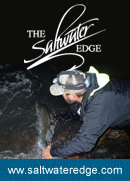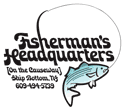Striped Bass Gamefish Rationale
This post by Capt John McMurray originally appeared on http://www.reel-time.com/on August 23rd
A case can be made, but it’s not the one we’re making
In my Aug 8th blog The Straight Dope on Striped Bass I mentioned “Assuming striped bass continues to decline, there is a rationale for gamefish, but thus far the angling community hasn’t picked up on it. I don’t really have the space to fully explain this here but will certainly do so in a future blog.” So… Let me do that now. If you haven’t read the above referenced blog, stop right here! Read it, then continue.
Let me be clear that on its face, gamefish doesn’t appear to be about conservation. It’s about a reallocation of a public resource. Again, on its face, it’s a policy decision, not a conservation one.
There was a comment following the blog along the lines that, according to my rationale, we should reopen market hunting for terrestrial game. Sounds silly, and it would be. But it is true that as long as total mortality is controlled, such populations would remain healthy. A dead duck is a dead-duck, likewise, a dead fish is a dead fish, regardless of who killed it. It matters little where the mortality comes from, it’s still mortality. As Charlie Witek pointed out in the comments section, wildlife managers simply chose broad public access over commercialization. It’s important to point out that this was not a decision mandated by biological imperatives. It was a policy decision on how to allocate limited resources. They chose the greater public rather than a few guys still trying to make a buck off of it.

A nice May striped bass – photo by Capt. John McMurray
Managers obviously haven’t done that with striped bass, and I don’t disagree that they should. I think decommercialization could achieve a number of objectives, yet I also feel like the entire striped bass gamefish issue has blinded people to the total fishing mortality issue, often to the extent that people can talk about killing smaller slot fish for dinner and then promote conservation in the same breath, while few notice that they’re talking out of both sides of their mouth.
If the true motivation is conservation, and I believe that at least with most gamefish advocates that’s the case, they could avoid a lot of grief by being very clear in their “conservation” goals. In other words, stop talking about killing small fish, either by reducing the minimum size or creating a slot limit, and shift the conversation toward reducing fishing mortality. Decommercializing the fishery may actually be a good way to do that but no one is taking that track, and frankly, I’m not sure they should be right now. I’ll explain this later.
I do believe that once we get the 2013 Benchmark assessment, reducing mortality, particularly on older fish, will quickly become a management goal. And, while the “fairness” issue still exists, decommercialization of striped bass is a realistic means to achieve it, particularly since decreasing recreational harvest is likely to lead to increased catch-and-release mortality. (Again I want to note here that in 2006, when the recreational fishery peaked, the number of fish killed as recreational discard mortality was double the total commercial catch).
However, such action would only be justifiable if the former commercial harvest is used as a buffer of sorts, to increase the population, and not merely transferred to recreational landings, as was the case in New Jersey when they went the gamefish route. I’m certainly not bashing Jersey. The fact is that, given the amount of fish they took from commercials and gave to anglers, only a small portion are actually killed pursuant to their 3rd “bonus program” fish, which I believe was suspended anyway last summer. So in reality, there is indeed a conservation benefit there. Of course that doesn’t translate to decision-makers who see only an unfair reallocation, perpetuated by a movement that, instead of promoting the conservation buffer idea, talks about killing a smaller fish. Certainly they get an earful about it from commercial striped bass fishermen in their states.
Getting back on point, decommercialization could indeed eliminate some bycatch-prone commercial gear such as gillnets and would stop the practice of discarding smaller, dead fish in favor of larger ones (“highgrading”) in order to maximize profit. (While I hate to say it, that sort of thing happens on charter/party boats as well.) Regardless, making striped bass a gamefish would likely quell the rampant illegal harvest along the coast. Sure there would still be some poaching, but certainly not to the extent that it has existed in the last two decades, since the profit motive would be eliminated.

A nice striper from the Navesink River – photo by Capt. Paul Eidman of Reel Therapy Charters
And then there is the economic argument. It’s pretty well established that anglers create quite a bit more economic activity than commercial striped bass fishermen. That’s been demonstrated in more than one academic study, and the argument that we deserve more fish, if not a total allocation, as a result has certainly been made. Yet, having spent the last five years on one of the regional fisheries management bodies, I can say with certainly that managers simply don’t do allocation based on economic value of the fishery. If that were the case, just about every dual-component fishery would have had all the fishery resources, except perhaps mackerel, tilefish and bluefin tuna, over to the recreational side. The economic value of those fisheries are heavily weighted to the commercial side; thus we probably would lose them all together if NMFS were to base allocation on economic impact. Several years ago, Stripers Forever retained Southwick Associates to prepare an economic study of the fishery, which unsurprisingly determined that economic activity generated by striped bass anglers was, I think, 26 times greater than that produced by the commercial fishery. But it mattered little. The ASMFC Committee on Economics and Social Sciences reviewed the study, then rejected it in its entirety. About a decade ago, the Virginia Institute of Marine Science also produced a study which concluded that allocating the entire striped bass harvest to anglers would yield the best economic result. It, too, was ignored.
That said, one could certainly argue that decommercialization is valuable not because it will permit a bigger recreational kill, but because it is a reasonable way to reduce overall striped bass mortality, increase the spawning stock, better assure the long-term health of the striped bass fishery and better represent the long term interests of the general public. However, simply reallocating the resource without reducing overall mortality fails to achieve any of those goals. The fact that the gamefish advocates haven’t tried to quell the “more fish for me” impression has really harmed anglers’ credibility with fishery managers and it has dealt commercial interests a winning hand
Several years ago, Stripers Forever President Brad Burns told me “If the striped bass were a personal-use-only species, the values of recreational fisherman would control its fate… Sure, a few would be eaten, but a healthy stock and high-quality fishing experience would be the primary values.” I think he’s right about that when we talk about fly fishermen and even a lot of the surfcasting community, but when you start to look at the party boats and the six-pack charters, along with a significant segment of the private boat community, a lot of bass are being killed. In those venues, conservation-minded sportsmen can be pretty thin on the ground.
First, Striped bass must be managed in a way that makes biological sense. Once that is achieved, like terrestrial game, bass should be managed in a way that brings the greatest overall benefit to the general public. Permitting the continued commercial exploitation of striped bass doesn’t really appear to achieve that objective. But, we have to keep in mind that this is a historical and culturally significant commercial fishery. We can’t expect it to just go away.

A nice striper from Capt. Dave Bitters at Baymen Charters
Unfortunately, a lot of anglers do think we can just make commercial fishermen disappear. Such people are still living in the “us vs. them” age. As I indicated in my Straight Dope column, I get it. It’s irritating to see one guy kill lots of fish 20 or so yards away from where you are releasing them all. But at a point in time so critical to the striped bass population, when we have a chance to convince managers to do the right thing, we’ve got to realize that it’s not about what is best for me, it’s about what’s best for the resource (although in the long run that’s usually the same thing).
So, while I do believe gamefish could have benefits for the stock, assuming the fish that had been harvested commercially were all maintained as a conservation buffer and not reallocated to anglers, I also believe that decommercializing striped bass is politically impossible at this time. Yet, since chasing that impossible goal tends to blind people to the total mortality issue, I can’t say I’m a big advocate anymore. There are other more important things on the table.
I’ll say it one more time, then I’ll shut up about bass, at least until we get the results of the benchmark: as a community greatly concerned with the future of this precious natural resource, we need to put the blinders on and focus solely on reducing fishing mortality. Clamoring about gamefish, slot limits etc., isn’t doing us any favors. There may be a time when there is an opportunity to achieve decommercialization, but that time is not now. Distracting ourselves from the most important goal of reducing mortality is likely to hurt the bass—and us—in the end.
After obtaining an undergraduate degree in Political Science from Loyola College in Maryland, Captain John McMurray served in the US Coast Guard for four years as a small-boat coxswain and marine-fisheries law enforcement officer. He was then recruited to become the first Executive Director of the Coastal Conservation Association New York. He is currently the Director of Grants Programs at the Norcross Wildlife Foundation in New York. He is the owner and primary operator of “One More Cast” Charters. John is a well known and well published outdoor writer, specializing in fisheries conservation issues. In 2006 John was awarded the Coastal Conservation Association New York Friend of Fisheries Conservation Award.












Living/Fishing in the Chesapeake Bay Area for some 70+ years I suggest you have low balled the total catch involved in illegal Striped Bass sales. Not only do the Commercials bend the system. The restaurants serving Striped Bass are very numerous and need Striped Bass from where ever it is available,sometimes from anglers. This is a huge industry in Maryland/North Carolina/Virginia that goes virtually untouched.
↓Going to more conservative limits on mortality on the recreational side is very difficult. We tried to do this in Rhode Island a number of years ago. Fisheries managers on the local AND federal level said if we went more conservative any decrease in Rhode island’s recreational take/mortality would/could be passed onto other states. Until the feds change their tune and allow a state to decrease their recreational mortality without then passing those fish to someone else you’ll see no extra conservation measures by individual states.
↓The debate always gets us confused. First we talk about conservation. Then we dive into 100 different opinions on slots and other complicated alternatives.
In the early 90s in NY and NJ it was one fish. 36 inches. You didnt always get a fish to take home. You either got lucky or you had to work for it. And it was mostly fished for by private boats, charter boats and surfcasters. Then more party and charter baots started fishing for bass and NY and NJ got a smaller fish and that extra fish. So there was a greater expectation that you would take something home.
I will never forget the full court press push for that extra fish in NY, depsite all the public comments from recreational anglers to the contrary.
“So who wants that extra fish, who wants the lower size, and why?” We asked.
“The silent majority,” we were told, by Pat Augustine and others.
This will not change unless these folks hear it from the rest of us, but we just don’t have the will and the organization to take up the fight.
↓Thanks for a great article John. As a surfcaster involved in a club we are constantly bombarded with information and opinions of what and what not to do… very confusing. I quote the great American Pogo
“We have met the enemy and it is us”
↓John
I am not commenting to be argumentative but to clear up a point I was making in my reply to your first post dated August 24th. In it I stated: “Striped bass larger than 28″ are ready to reproduce and have developed survival skills. Therefore, I support the keeping of a striped bass through a tag program. Each participating fisherman can keep any size bass if they still have a tag remaining from an amount issued at the beginning of each season; I would suggest 3-4 tags per fisherman. The tags should be non-transferable and once used, no additional tags would become available. The tags must be filled in to assure that no tag is reused. This system tied to greater enforcement is a sensible way to proceed and would help to increase the number of striped bass.”
My response outlines 2 points I guess I failed to clearly make since your interpretation is different then the one I hoped to make:
First: The quantity of fish kept each season by each fisherman would be limited to the number of tags issued per fisherman: be it 2, 3, or 4. The number of tags issued can be designed to decrease the overall number of bass kept each year.
Second: Although the same number of fish may be kept by each fisherman after the issuance of the tags as compared with the current policy (but I believe there would be less fish kept overall) then the number of larger reproducing ready fish would be spared. Ultimately these larger fish that were spared would reproduce and the number of striped bass would increase. These larger fish have already developed skills and habits the would offer them a better chance of surviving and reproducing.
Personally, I rarely keep a bass. A 28″ fish is too much fish for my wife and myself. I would rather keep a 16″ fish that must taste better than a larger one and also contains less PCB and other contaminants.
Thank you for your service to the fishing community,
↓Frank
John, I want to offer my encouragement to you to, 1) keep writing logical, informative, and in my opinion non-biased articles. Very well done. and 2) to stay involved in this work to keep striped bass a resource for us all to enjoy into the foreseeable future. We need more voices like yours…”we need to put the blinders on and focus solely on reducing fishing mortality.” Hopefully there will be a day soon when we can discuss the benefits of each method, and I appreciated your views on the “gamefish” approach.
↓I most likely will never sit on an advisory board, or make policy concerning the striped bass, but as an angler I can have a practical effect every time I’m on the water. When others see us happily put a bass back in the water, it makes an impression. The smile on my face watching a nice bass swim away after a hard fought battle must be infectious, because I’ve gotten more than one question or comment. We can ALL do that.
I’m in
↓